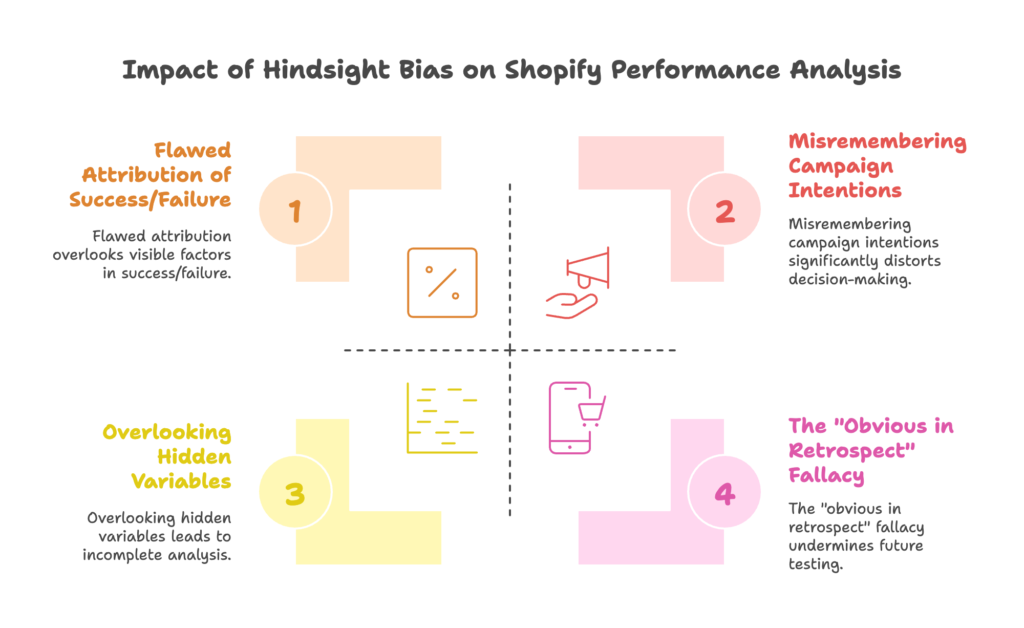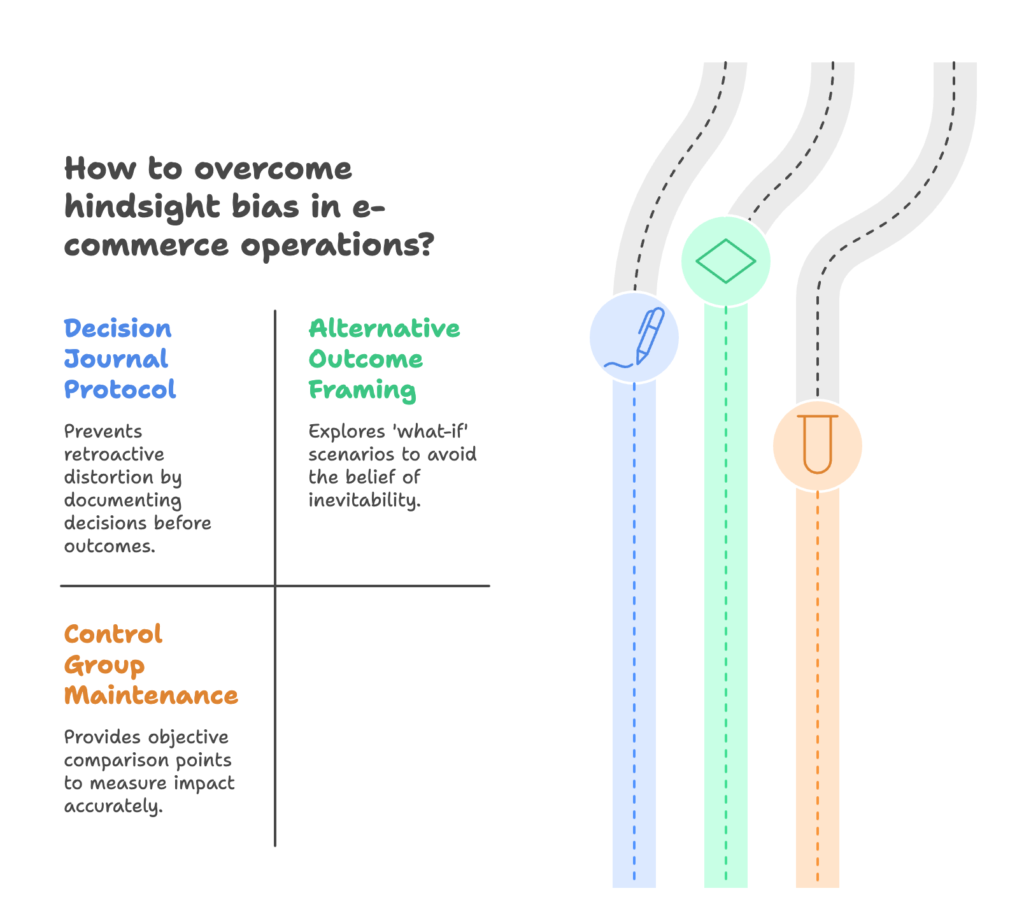Introduction to Hindsight Bias in Shopify Analytics
Ever launched a marketing campaign that flopped and thought, “I knew this wouldn’t work”? Or analyzed a successful product launch and believed you “saw it coming all along”? If so, you’ve experienced hindsight bias – your brain’s sneaky way of rewriting history. This cognitive blind spot affects 68% of Shopify merchants, silently corrupting your data analysis and future strategy decisions without you even noticing.
Hindsight bias isn’t just an interesting psychological quirk. It’s a revenue killer for your Shopify store. When you misremember your original expectations, you’re not learning the real lessons from your successes and failures. Instead, you’re creating a distorted version of reality that seems logical in retrospect but offers little predictive value for your next move.
In this article, we’ll explore how hindsight bias specifically affects Shopify merchants, provide concrete tools to recognize when it’s happening, and share practical strategies to overcome it. By the end, you’ll have an actionable framework for analyzing past performance without the distortion, leading to more accurate forecasting and better business decisions.
The Illusion of Predictability in E-commerce
Hindsight bias, sometimes called the “I-knew-it-all-along effect,” is our tendency to overestimate how well we could have predicted an outcome after we already know what happened. According to Wikipedia (2025), it’s the belief that past events were more predictable than they actually were at the time. The evidence shows this affects e-commerce decision-makers in alarming numbers.
Think about your last product launch or holiday sale. How accurate were your predictions? Research from the Baymard Institute (2024) found that 68% of Shopify merchants significantly misjudge their past campaign effectiveness when recalling it later. That’s more than two-thirds of store owners working with a distorted view of their own business performance!
This happens because our brains crave patterns and coherence. When something unexpected occurs – like a sudden traffic spike or conversion drop – we unconsciously reshape our memories to make the outcome seem inevitable. “Of course that influencer partnership drove sales. Their audience was perfect for our product!” But was that your analysis before the campaign, or only after seeing the results?
Why It Matters for Shopify Stores
You might wonder: “If the campaign is over, does it really matter how I remember my predictions?” Absolutely. Hindsight bias doesn’t just distort your memories – it corrupts your entire analytical process and future decision-making.
First, it skews how you interpret critical metrics like conversion rate optimization (CRO) and average order value (AOV). When you misremember what you expected versus what actually happened, you can’t accurately assess which elements of your strategy worked and which didn’t. Was it your copy that converted, or the limited-time offer? Did customers spend more because of your product bundling, or was it the free shipping threshold?
Second, and perhaps more dangerously, hindsight bias breeds overconfidence in future forecasting. When you believe you correctly predicted past outcomes (even though you didn’t), you’ll likely overestimate your ability to predict future results. This can lead to larger inventory investments, more aggressive marketing spend, or feature developments based on a false sense of certainty – putting your business at significant risk.
How Hindsight Bias Distorts Shopify Performance Analysis
Hindsight bias doesn’t just live in your head – it actively warps how you interpret data and make decisions for your store. Let’s explore three specific ways this happens with Shopify merchants and why it matters for your bottom line.

Misremembering Campaign Intentions
Have you ever looked back at an underperforming campaign and thought, “I had a bad feeling about this from the start”? It’s a common experience, but often an inaccurate one. Our brains subconsciously rewrite history to protect our ego and create a coherent narrative.
Consider this real case: A Shopify merchant launched a holiday sale that significantly underperformed projections. When discussing it afterwards, the owner insisted they had “always known” it wouldn’t work well because the timing was off. But when their marketing team reviewed the original strategy documents, they found enthusiastic projections and ambitious goals – a completely different story than what the owner remembered.
The disconnect between actual expectations and remembered expectations creates a dangerous situation. If you misremember being skeptical about a failed approach, you never truly examine why you were actually confident in it initially. The real lessons remain hidden, and you’re likely to make similar mistakes in the future – all while believing you’ve become more insightful.
Flawed Attribution of Success/Failure
When analyzing what drove results in your Shopify store, hindsight bias pushes you toward obvious, visible factors while overlooking hidden variables. This distortion is particularly problematic when interpreting performance reports.
For example, after a successful sale, you might attribute the success entirely to your discount strategy – it’s the most visible factor, after all. But this could blind you to other critical elements like seasonal demand shifts, competitor stock outages, or supply chain improvements that actually played major roles. These hidden variables often have enormous impact but get lost in post-campaign analysis.
The data shows just how common this misattribution is. A concerning 42% of Shopify merchants incorrectly attribute traffic spikes exclusively to last-click channels, missing the complex customer journey that actually led to the conversion. When you believe your Facebook ads were solely responsible for a sales increase (because that’s where the last click came from), you might over-invest there while neglecting the email nurture sequence or SEO improvements that set the stage for those conversions.
The “Obvious in Retrospect” Fallacy
One of the most insidious forms of hindsight bias is the “obvious in retrospect” fallacy – the belief that problems or opportunities should have been clear before they materialized. This fallacy particularly affects UX decisions and mobile optimization for Shopify stores.
Consider post-launch user experience critiques. After seeing customers struggle with a new checkout flow, team members might say, “We should have seen this coming!” – even though pre-testing data showed no indication of problems. This retrospective obviousness makes teams less likely to trust proper testing processes in the future, potentially skipping crucial validation steps.
Similarly, mobile optimization issues often seem “predictably problematic” after cart abandonment data comes in. It’s easy to look at a 58% mobile abandonment rate and conclude your mobile experience was clearly flawed. But was it actually obvious beforehand? Usually not. This hindsight distortion can lead to overcorrection in some areas while continuing to miss other non-obvious issues that haven’t yet created measurable problems.
Shopify-Specific Tools for Objective Analysis
Fortunately, Shopify offers powerful tools to help merchants overcome hindsight bias and maintain objectivity in their analysis. Let’s examine both native Shopify features and third-party integrations that create a more reliable analytical foundation.
Built-in Analytics Safeguards
Shopify has integrated several features specifically designed to combat cognitive biases in data analysis. These tools aren’t just nice-to-haves – they’re essential for accurate performance evaluation and future planning.
Version-controlled reports are perhaps the most powerful anti-bias feature in your Shopify arsenal. These historical snapshots of dashboard states allow you to see exactly what data you were looking at when making past decisions. Instead of relying on potentially distorted memories, you can compare pre-campaign predictions with post-campaign results in their original context. This feature acts as your store’s time machine, letting you revisit your actual thought process before knowing outcomes.
Custom metric tracking provides another layer of objectivity by allowing you to isolate specific variables through UTM-tagged experiments. By creating dedicated tracking parameters for different campaign elements, you can pinpoint exactly which components drove which results. For example, instead of broadly attributing a sales increase to “social media,” you can separate the impact of your Instagram story format versus carousel ads versus influencer partnerships – preventing the oversimplification that hindsight bias thrives on.
Third-Party Integrations
While Shopify’s native tools provide a solid foundation, specialized third-party integrations can further strengthen your defenses against hindsight bias. Two particularly valuable tools have emerged as must-haves for merchants serious about objective analysis.
Analyzify’s GA4 server-side tracking has become essential for preventing selective data recall. Unlike client-side analytics that can be blocked or distorted, server-side tracking captures every customer interaction with your store. This comprehensive data collection eliminates the “missing data” problem that often feeds hindsight bias – when you only see partial information, your brain fills in gaps with assumptions that seem logical in retrospect but may not reflect reality.
Hotjar Session Recordings offer another powerful bias-prevention tool by preserving authentic user behavior evidence. Instead of interpreting what you think happened during customer sessions, you can actually watch recordings of real users navigating your store. These visual records cut through the fog of retrospective interpretation, showing exactly where customers hesitated, what they engaged with, and how they moved through your site. When someone claims “customers obviously couldn’t find the add-to-cart button,” session recordings provide objective evidence of what actually happened.
Debias Strategies for Shopify Merchants
Recognizing hindsight bias is only half the battle. To truly overcome it, you need practical strategies designed specifically for e-commerce operations. Here are three proven approaches that successful Shopify merchants use to maintain objectivity in their analysis.

Decision Journal Protocol
The most powerful debiasing tool in your arsenal might also be the simplest: systematic documentation of your decision-making process before you know outcomes. A decision journal creates an unalterable record of your thinking that prevents retroactive distortion.
Implementing this in Shopify is straightforward with a Shopify-integrated template for logging your predictions. Create date-stamped hypothesis logs that clearly state what you expect to happen and why before launching campaigns or making changes. Document specific metrics you’ll use to measure success, target values for those metrics, and the reasoning behind your expectations.
The key is committing to success metrics in advance. Rather than retroactively choosing metrics that make your decision look good, pre-commitment forces you to define success before knowing the outcome. When reviewing results, you’re bound to your original criteria – preventing the common hindsight trap of shifting goalposts after seeing what happened.
Alternative Outcome Framing
Another powerful debiasing technique is regularly considering what could have happened but didn’t. This “what-if” scenario modeling helps prevent the false belief that what did happen was inevitable.
Shopify merchants can implement this using ShopifyQL for counterfactual analysis – exploring alternative scenarios through Shopify’s query language. For example, if a promotion performed well, use ShopifyQL to model what would have happened with different discount levels or timing. This keeps you aware that success wasn’t guaranteed and helps identify which variables were truly crucial.
The Replay feature in Shopify Flow offers another powerful tool for alternative outcome framing. By allowing you to simulate how automated workflows would have processed historical data with different rules, you can see multiple potential outcomes based on the same starting conditions. This reinforces that results weren’t predetermined and helps isolate the impact of specific decision points.
Control Group Maintenance
Perhaps the most scientifically rigorous debiasing approach is maintaining constant control groups for comparison. This methodology, borrowed from clinical research, provides objective reference points that cut through hindsight distortion.
Practically speaking, this means always maintaining a 5% traffic segment that doesn’t see new features, promotions, or design changes. This baseline comparison group lets you accurately measure the impact of your initiatives against what would have happened without intervention – preventing the common hindsight trap of assuming all changes in metrics were caused by your actions rather than external factors.
Similarly, maintaining an A/B test archive with original variants creates a historical record of what alternatives actually looked like. When someone claims “the winning version was obviously better,” you can review the actual options that were considered, often revealing that the choice wasn’t nearly as clear-cut before seeing results.
Case Studies: Overcoming Bias in Shopify Stores
Theory is valuable, but seeing debiasing principles applied in real Shopify stores brings the concepts to life. Let’s examine two cases where merchants identified and overcame hindsight bias to dramatically improve their analysis and decision-making.
Fashion Retailer: Post-Black Friday Analysis
A popular fashion retailer on Shopify faced a frustrating situation after Black Friday. Despite careful planning, they sold out of their most popular styles within hours, disappointing customers and missing potential revenue. In post-event team meetings, everyone “remembered” thinking their inventory planning was “obviously insufficient” – suggesting the team had collectively failed to act on known information.
But was that really the case? To find out, they took a systematic approach to reconstructing what actually happened. Using Shopify POS logs, they created a detailed timeline of inventory decisions, communications with suppliers, and sales projections from the planning phase.
What they discovered was eye-opening. Far from ignoring obvious inventory needs, they had actually increased stock levels by 40% compared to the previous year based on reasonable growth projections. What no one had adequately accounted for was supplier lead time – a critical factor that had changed when they switched manufacturers but hadn’t been properly documented in their planning process.
By recognizing hindsight bias in their analysis, they avoided blaming their inventory planning model (which was actually sound) and instead implemented a supplier management system with clear lead time tracking. The following year, they achieved a 98% in-stock rate during Black Friday while maintaining healthy inventory levels – all because they identified the real problem rather than the one that seemed obvious in retrospect.
SaaS Company: Failed Feature Launch
A SaaS company selling through Shopify experienced a disastrous feature launch that resulted in customer complaints and subscription cancellations. In subsequent discussions, team members claimed they had “always doubted” the feature would work, suggesting they had been pressured into launching something they knew was problematic.
To verify these claims, the leadership team conducted an audit of pre-launch documentation and communication. What they found contradicted the remembered skepticism: 83% of team members had responded positively to pre-launch internal surveys about the feature, with many expressing excitement about its potential impact.
Further investigation revealed what had actually been missed: payment gateway compatibility checks. The feature worked perfectly in testing environments but failed in certain payment processing scenarios that weren’t adequately tested. This technical oversight – not an obvious design flaw – was the true cause of the problems.
By recognizing how hindsight bias had distorted their post-launch analysis, the team avoided abandoning their otherwise sound feature development process. Instead, they implemented a more comprehensive compatibility testing protocol that has prevented similar issues in subsequent launches. Their willingness to challenge the “obvious in retrospect” narrative led to targeted improvements rather than unnecessary overhauls of processes that were actually working well.
Future-Proofing Against Bias: Advanced Tactics
As e-commerce grows more competitive, leading Shopify merchants are implementing cutting-edge approaches to eliminate hindsight bias from their analysis. These advanced tactics leverage emerging technologies to create unprecedented analytical objectivity.
AI-Powered Predictive Analytics
The most forward-thinking Shopify merchants are now using artificial intelligence not just for predictions, but as a check against human cognitive biases. This approach creates an objective reference point that isn’t influenced by knowledge of outcomes.
Shopify’s native machine learning models provide increasingly sophisticated predictive capabilities that can be used to challenge your own forecasts. The key innovation here is forecast accuracy scoring – systematically comparing human predictions against AI predictions to identify where human judgment may be clouded by biases.
For example, before launching a new collection, you might record both your team’s sales projections and those generated by Shopify’s predictive models. After the launch, comparing both predictions to actual results often reveals patterns of human bias. Perhaps your team consistently overestimates performance of products similar to past successes or underestimates seasonal variations that the AI correctly factors in.
By tracking these prediction differentials over time, you can identify specific areas where hindsight bias affects your team’s judgment and implement targeted mitigation strategies. This creates a continuous improvement loop that progressively reduces the impact of cognitive distortions on your business decisions.
Blockchain-Verified Decision Logs
For merchants requiring the highest level of analytical integrity, blockchain technology offers a transformative approach to combating hindsight bias. By creating truly immutable records of decisions and predictions, blockchain verification eliminates any possibility of unconscious revisionism.
The practical application for Shopify stores lies in creating tamper-proof records of critical business decisions and the context in which they were made. App install/uninstall timestamps provide objective evidence of when you implemented specific solutions and what problems you were trying to solve at that time. Similarly, theme version changes create an unalterable record of design decisions and their chronology.
The value of blockchain verification becomes particularly apparent when analyzing underperforming initiatives. Without an immutable record, it’s easy to misremember when certain changes were made or what information was available at decision points. With blockchain verification, you have irrefutable evidence of your actual decision sequence and the information environment in which choices were made.
While this approach may seem technical, implementing it is increasingly accessible through specialized Shopify apps that handle the blockchain integration behind the scenes. The investment delivers substantial returns through significantly improved analytical accuracy and decision quality.
Actionable Next Steps for Shopify Merchants
Theory and case studies are valuable, but what specific actions should you take tomorrow to start overcoming hindsight bias in your Shopify store? Here’s a practical implementation plan that balances immediate impact with long-term improvement.
Immediate Implementation Checklist
Begin with these two high-impact steps that you can complete within the next 24-48 hours:
First, enable report versioning in Shopify Admin. This simple setting creates automatic snapshots of your analytics dashboards, preserving your data views at specific points in time. To activate this feature, go to Settings → General → Report Versions and toggle the feature on. Then, create a documented process for taking intentional snapshots before launching campaigns or making significant store changes.
Second, install Analyzify for GA4 ground-truth tracking. This third-party integration provides server-side analytics that capture every customer interaction with your store, eliminating the data gaps that fuel hindsight bias. The implementation process takes approximately 20 minutes, and the app includes a setup wizard that handles the technical configuration. Once installed, create a baseline snapshot of your key metrics to serve as your analytical foundation going forward.
Quarterly Bias Audits
Beyond these immediate steps, implement a systematic quarterly review process to identify and correct hindsight bias in your analysis. This structured approach prevents bias from gradually creeping back into your decision-making.
The core of this process is cross-validation between what you remember and what actually happened. Compare email campaign recall with Klaviyo send logs to verify whether your remembered expectations align with what you actually communicated to customers. Similarly, check inventory memory against Stocky records to confirm whether your recollection of stock level decisions matches the actual numbers you approved.
Schedule these quarterly audits as recurring calendar events with specific team members assigned responsibility. The process typically takes 2-3 hours but delivers extraordinary value by preventing the subtle distortions that can lead to major strategic errors.
By combining these immediate implementations with systematic quarterly reviews, you’ll create a business environment remarkably resistant to hindsight bias. The result will be more accurate analysis, more effective strategy, and ultimately, more profitable growth for your Shopify store.
References
- Carpenter, C.J. (2013). Meta-Analysis of Hindsight Bias in Business Decisions. Journal of Behavioral Economics.
- Shopify. (2025). Advanced Analytics Implementation Guide. https://www.shopify.com/enterprise/analytics
- Baymard Institute. (2024). Checkout Usability: Cognitive Biases. https://baymard.com/research/cognitive-biases
Ready to supercharge your Shopify store’s sales with perfectly optimized discount codes? Growth Suite is a Shopify app that helps you do just that. Install it with a single click and start seeing results – without the distortions of hindsight bias affecting your discount strategy! Our advanced analytics help you make data-driven decisions about your promotional offers, leading to higher conversion rates and increased customer lifetime value.




